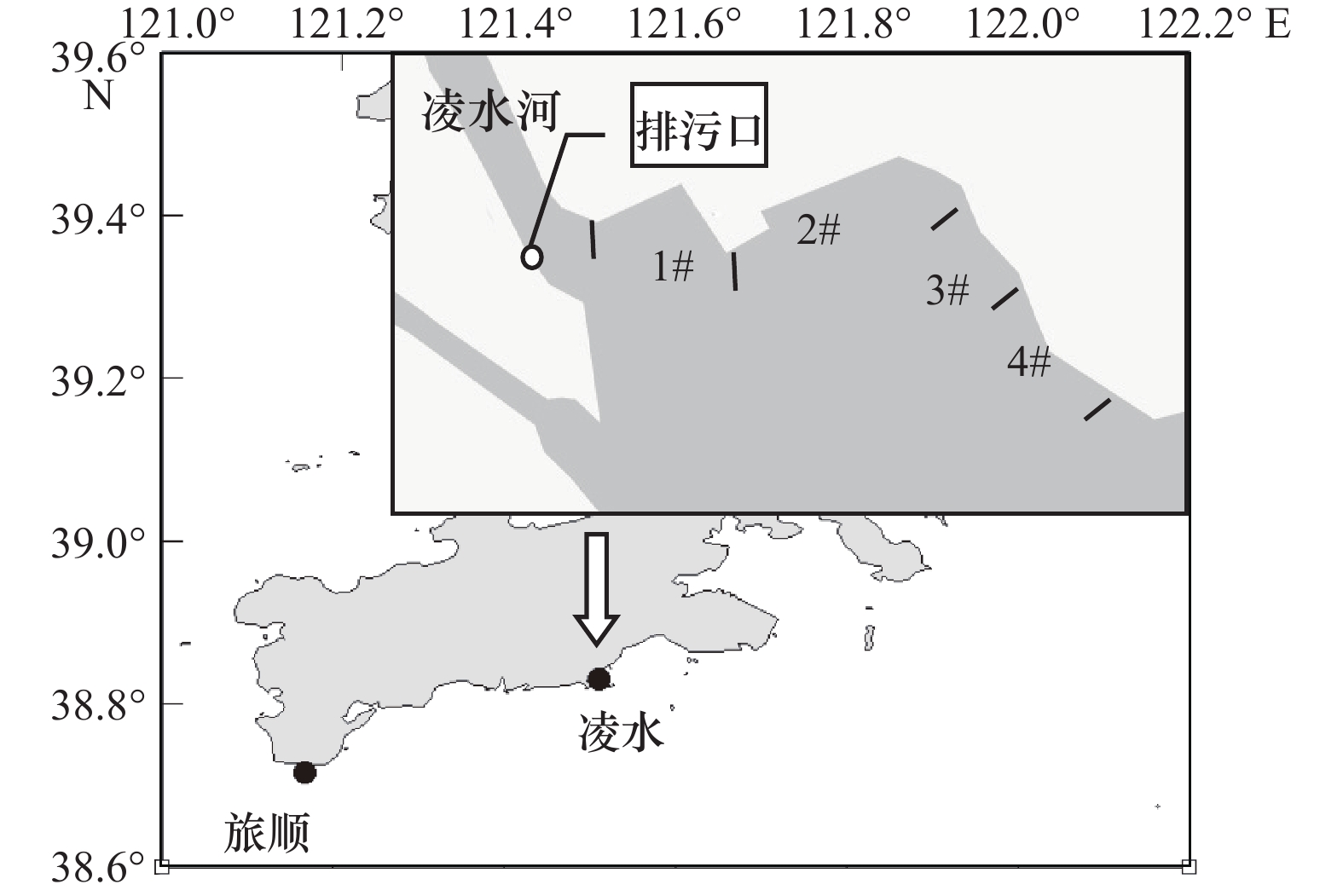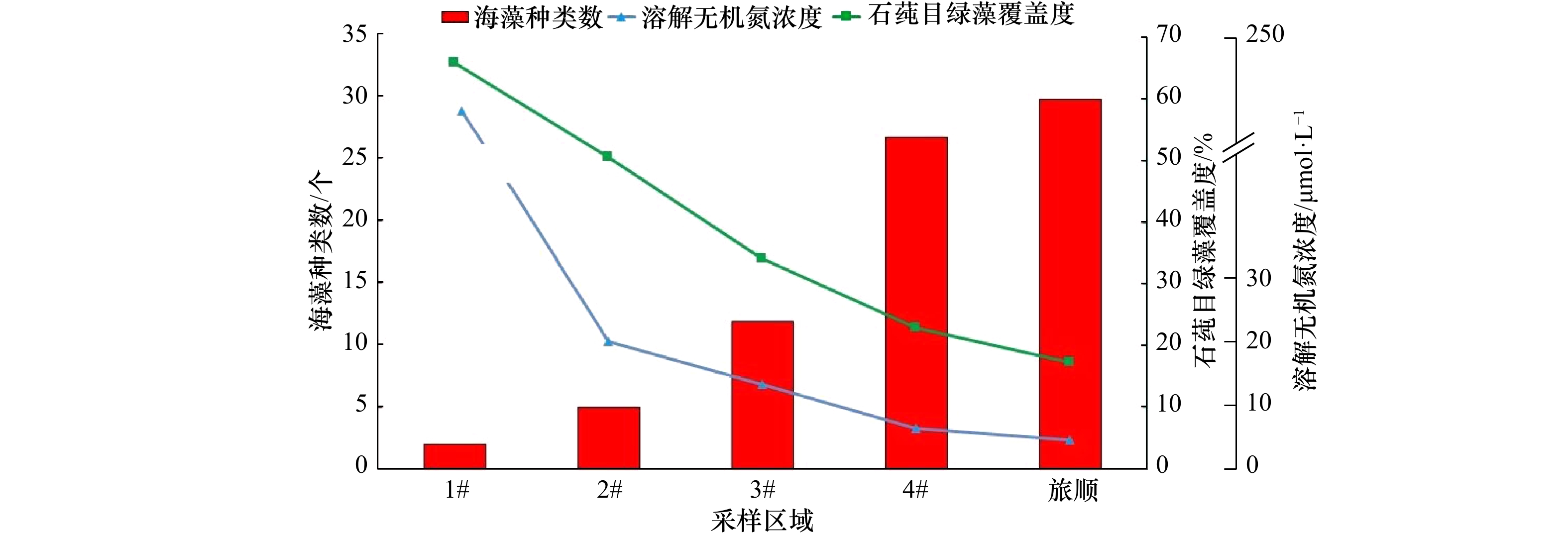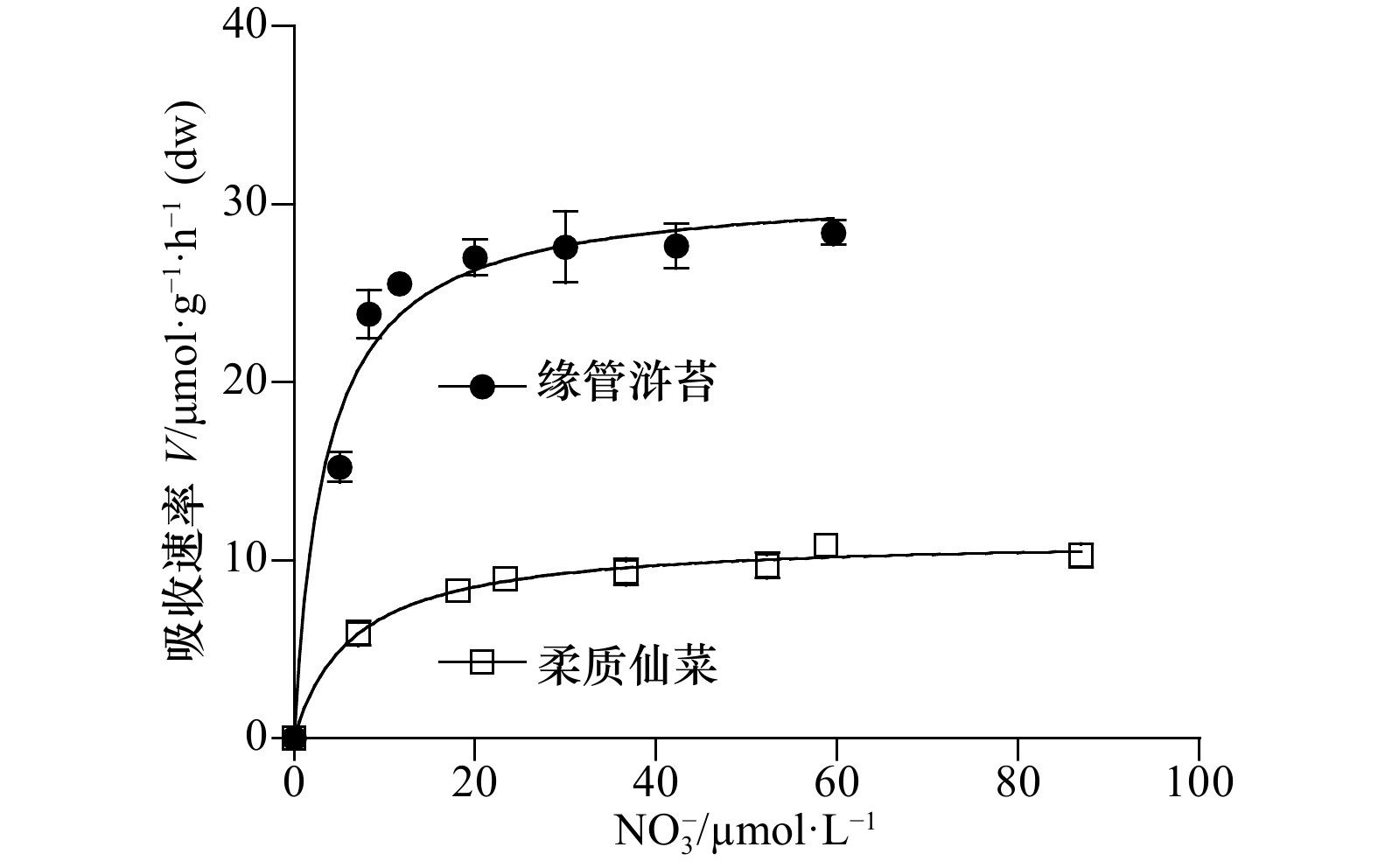The impact of nutrient inputs from sewage effluents on the adjacent intertidal seaweed communities
-
摘要: 伴随着经济的发展,我国沿海海域富营养化日趋严重。为了明确富营养化对底栖海藻群落的影响及作用机制,本文选择了与大连凌水河口(污水河)毗邻的海藻床作为野外观测点,研究底栖海藻群落对营养盐自然衰减梯度的响应规律;在实验室内,选择了在排污口附近优势分布、营r-生态策略的绿藻缘管浒苔和仅在寡营养区域分布、营k-生态策略的红藻柔质仙菜作为实验材料,开展了营养吸收动力学和生长动力学研究。通过二者在营养盐吸收、利用和繁殖策略方面的比较研究,剖析了底栖海藻群落对不同营养环境的响应机制。结果显示:随着海水中营养盐浓度的降低,底栖海藻群落呈现种类数增加、优势种覆盖度降低的趋势。根据底栖海藻在群落水平对氮源营养的响应,认为现行海水水质标准中无机氮一类水质标准的限值应该由目前的14.29 μmol/L降低为6.69 μmol/L。在富营养环境中,营养盐浓度的上升促进了r-策略海藻幼体的竞争力和种群繁殖力,使其占据了大量的生态位,形成优势种群,导致底栖海藻多样性较低;在寡营养环境中,由于得不到充足的营养盐供应,r-策略海藻幼体的竞争力和种群繁殖力都受到制约,占据的空间生态位有限,为其他种类的生存提供了条件,而那些对营养盐需求较低但利用效率高的k-策略海藻则表现出更强的竞争力,在竞争中取得优势,能快速突破早期环境筛的限制,形成成体,因此,在寡营养海域,底栖海藻的多样性比较丰富。Abstract: Nutrient enrichment, followed by economic development, has already had a significant impact on the costal ecosystem of China. Field investigations on seaweed beds adjacent to Lingshui River in Dalian were conducted in present studies to elucidate the response of the seaweed communities to the sewage effluents along a natural nutrient gradient. Further, the studies were conducted in the laboratory on the uptake and growth kinetics of NO3–, NH4+ and PO43– of the clone of Enteromorpha linza, r-strategic green alga dominating in the nutrient-rich estuaries, and Ceramium tenerrimum, k-strategic red alga distributing in the oligotrophic areas. Comparative analyses were carried out on the absorption and utilization of nutrient, and reproduction strategies of the two species to explain the responses of seaweed communities to different nutrient environments. The results show that with the decrease of environmental nutrients, species number of seaweed increases, and the coverage of dominant species decreases. According to the response of seaweed communities to nitrogen nutrient, it is considered that the threshold of category I of inorganic nitrogen in the current seawater quality standard should be revised from the current 14.29 μmol/L to 6.69 μmol/L. In a nutrient-rich area, increasing nutrient concentration promotes the competitiveness and fertility of shoots of r-strategic seaweeds, which makes them occupy a large number of space niches and form dominant populations, resulting in decreasing of the diversity of seaweed communities. However, in the oligotrophic environment, r-strategic algae is limited in the fertility of shoots, occupying only small amount of space niche, while those k-strategic algae with high efficiency in nutrient utilization shows greater competitiveness and could quickly break through early environmental sieves and grow into adults, which contributes to the rich diversity of seaweed communities.
-
表 1 各区域营养状况及底栖海藻分布情况
Tab. 1 Nutritional status and distribution of seaweeds in various sections
区域 凌水河口海域 旅顺黄金山海域 1# 2# 3# 4# 营养状况/μmol·L–1 $ {\rm {NO}} _3^- $ 121.02±24.95 13.03±2.28 10.12±1.51 5.96±0.78 4.24±1.66 $ {\rm {NO}} _2^- $ 54.89±8.87 3.92±1.17 1.62±0.40 0.06±0.02 0.07±0.01 ${\rm {NH}} _4^+ $ 66.09±5.85 3.86±0.91 1.99±0.41 0.68±0.16 0.47±0.08 DIN 242.00±29.94 20.81±6.36 13.74±3.73 6.69±0.88 4.79±1.56 ${\rm {PO}} _4^{3-} $ 51.36±14.71 3.56±0.55 3.79±0.81 1.03±0.39 0.48±0.13 N/P 4.71±1.66 5.85±1.21 3.63±0.30 6.50±1.39 9.98±2.97 海藻分布 种类数/个 2 5 12 27 30 绿藻覆盖度 66.0%±10.7% 50.6%±4.5% 34.1%±3.9% 22.9%±3.2% 17.3%±2.7% 表 2 两种海藻对营养盐的吸收动力学参数
Tab. 2 Kinetics parameters for different nutrient uptake by two species
营养源 供试海藻 Vmax/μmol·g–1·h–1(dw) Ks/μmol·L–1 a (Vmax/ Ks) R2 吸收方式 ${\rm {NO}}_3^{-} $ 缘管浒苔 30.9±0.9b 3.5±0.5a 8.9 0.97 主动运输 柔质仙菜 11.3±0.3a 6.5±0.9b 1.7 0.97 主动运输 ${\rm {NH}}_4^+ $ 缘管浒苔 1.7×S – – 0.99 被动扩散 柔质仙菜 70.5±3.2 b 28.0±3.6 b 2.5 0.97 主动运输 $ {\rm {PO}}_4^{3-} $ 缘管浒苔 4.2±0.1a 0.9±0.2 a 4.7 0.96 主动运输 柔质仙菜 6.5±0.9 a 13.7±3.6 b 0.5 0.94 主动运输 注:S表示培养基中对应的营养盐浓度;不同字母(a和b)表示差异显著(P<0.05)。 表 3 两种海藻氮营养生长动力学参数
Tab. 3 Kinetics parameters for nitrogen growth of two species
氮源 背景生长率/d–1 最大净生长率/d–1 Kμ/μmol·L–1 R2 硝酸氮 缘管浒苔 3.5%±0.6%a 10.4%±0.7%b 20.7±6.5b 0.99 柔质仙菜 1.5%±0.1%a 2.3%±0.1%a 9.6±1.7b 0.99 氨氮 缘管浒苔 3.9%±0.4%a 7%±0.5% b 26.2±8.7b 0.93 柔质仙菜 1.6%±0.4%a 2.1%±0.2%a 17.6±4b 0.87 注:不同字母(a和b)表示差异显著(P<0.05)。 表 4 两种海藻的Kμ/Ks
Tab. 4 Kμ/Ks of two species seaweeds
种类 缘管浒苔 柔质仙菜 Kμ/Ks 5.92 1.47 -
[1] 国家海洋局. 2017中国海洋生态环境状况公报[R]. 北京: 国家海洋局, 2018.State Oceanic Administration. Bulletin of Marine Environmental Status of China in 2017[R]. Beijing: State Oceanic Administration, 2018. [2] Lapointe B E, Barile P J, Matzie W R. Anthropogenic nutrient enrichment of seagrass and coral reef communities in the lower Florida keys: discrimination of local versus regional nitrogen sources[J]. Journal of Experimental Marine Biology and Ecology, 2004, 308(1): 23−58. doi: 10.1016/j.jembe.2004.01.019 [3] Schramm W. Factors influencing seaweed responses to eutrophication: some results from EU-project EUMAC[J]. Journal of Applied Phycology, 1999, 11(1): 69−78. doi: 10.1023/A:1008076026792 [4] Raven J A, Taylor R. Macroalgal growth in nutrient-enriched estuaries: a biogeochemical and evolutionary perspective[J]. Water, Air, and Soil Pollution: Focus, 2003, 3(1): 7−26. doi: 10.1023/A:1022167722654 [5] Morand P, Briand X. Excessive growth of macroalgae: a symptom of environmental disturbance[J]. Botany Marina, 1996, 39(1/6): 491−516. [6] Morand P, Merceron M. Coastal eutrophication and excessive growth of macroalgae[J]. Recent Research Developments in Environmental Biology, 2004, 1(2): 395−449. [7] Liu Dongyan, Bai Jie, Song Shuqun, et al. The impact of sewage discharge on the macroalgae community in the Yellow Sea coastal area around Qingdao, China[J]. Water, Air, & Soil Pollution: Focus, 2007, 7(6): 683−692. [8] Rosenberg G, Probyn T A, Mann K H. Nutrient uptake and growth kinetics in brown seaweeds: response to continuous and single additions of ammonium[J]. Journal of Experimental Marine Biology and Ecology, 1984, 80(2): 125−146. doi: 10.1016/0022-0981(84)90008-X [9] Hwang S P L, Williams S L, Brinkhuis B H. Changes in internal dissolved nitrogen pools as related to nitrate uptake and assimilation in Gracilaria tikvahiae McLachlan[J]. Botany Marina, 1987, 30: 11−19. [10] Wallentinus I. Comparisons of nutrient uptake rates for Baltic macroalgae with different thallus morphologies[J]. Marine Biology, 1984, 80(2): 215−225. doi: 10.1007/BF02180189 [11] Fong P, Boyer K E, Desmond J S, et al. Salinity stress, nitrogen competition, and facilitation: what controls seasonal succession of two opportunistic green macroalgae?[J]. Journal of Experimental Marine Biology and Ecology, 1996, 206(1/2): 203−221. [12] Littler M M, Littler D S. The evolution of thallus form and survival strategies in benthic marine macroalgae: field and laboratory tests of a functional form model[J]. The American Naturalist, 1980, 116(1): 25−44. doi: 10.1086/283610 [13] Raffaelli D G, Raven J A, Poole L J. Ecological impact of green macroalgal blooms[J]. Oceanography and Marine Biology, 1998, 36: 97−125. [14] Fletcher R L. The occurrence of “Green Tides”-A Review[M]//Schramm W, Nienhuis P H. Marine Benthic Vegetation: Recent Changes and the Effects of Eutrophication. Berlin, Heidelberg: Springer-Verlag, 1996: 7–43. [15] Duke C S, Litaker W, Ramus J. Effects of temperature, nitrogen supply, and tissue nitrogen on ammonium uptake rates of the chlorophyte seaweeds Ulva curvata and Codium decorticatum[J]. Journal Phycology, 1989, 25(1): 113−120. doi: 10.1111/jpy.1989.25.issue-1 [16] Lotze H K, Schramm W. Ecophysiological traits explain species dominance patterns in macroalgal blooms[J]. Journal of Phycology, 2000, 36(2): 287−295. [17] Vadas R L, Johnson S, Norton T A. Recruitment and mortality of early post-settlement stages of benthic algae[J]. British Phycological Journal, 1992, 27(3): 331−351. doi: 10.1080/00071619200650291 [18] Saito Y, Atobe S. Phytosociological study of intertidal marine algae. I. Usujiri benten-jima, hokkaid[R]. Hokkaido: Bulletin of the Faculty of Fisheries, Hokkaido University, 1971, 21: 37–69. [19] 邵魁双, 巩宁, 李珂, 等. 缘管浒苔和假根羽藻氮磷营养生理学研究[J]. 海洋学报, 2011, 33(3): 131−139.Shao Kuishuang, Gong Ning, Li Ke, et al. Nitrogen and phosphorus nutrition physiology of Enteromorpha linza and Bryopsis plumosa (Cholorophyta)[J]. Haiyang Xuebao, 2011, 33(3): 131−139. [20] 郭卫东, 章小明, 杨逸萍, 等. 中国近岸海域潜在性富营养化程度的评价[J]. 台湾海峡, 1998, 17(1): 64−70.Guo Weidong, Zhang Xiaoming, Yang Yiping, et al. Potential eutrophication assessment for Chinese coastal waters[J]. Journal of Oceanography in Taiwan Strait, 1998, 17(1): 64−70. [21] Pedersen M F, Borum J. Nutrient control of estuarine macroalgae: growth strategy and the balance between nitrogen requirements and uptake[J]. Marine Ecology Progress Series, 1997, 161: 155−163. doi: 10.3354/meps161155 [22] 邵魁双, 李熙宜. 大连海区潮间带底栖海藻生物群落的季节变化[J]. 大连水产学院学报, 2000, 15(1): 29−34. doi: 10.3969/j.issn.1000-9957.2000.01.005Shao Kuishuang, Li Xiyi. Seasonal variation of benthic seaweed community in the intertide in Dalian[J]. Journal of Dalian Fisheries University, 2000, 15(1): 29−34. doi: 10.3969/j.issn.1000-9957.2000.01.005 [23] Nixon S W, Pilson M E Q. Nitrogen in estuarine and coastal marine ecosystems[M]//Carpenter E J, Capone D G. Nitrogen in the Marine Environment. New York: Plenum Press, 1983: 565–590. [24] Oviatt C, Doering P, Nowicki B, et al. An ecosystem level experiment on nutrient limitation in temperate coastal marine environments[J]. Marine Ecology Progress Series, 1995, 116: 171−179. doi: 10.3354/meps116171 [25] Howarth R W, Anderson D, Cloern J, et al. Nutrient pollution of coastal rivers, bays, and seas[J]. Issues in Ecology, 2000, 7: 1−15. [26] 梁倩倩, 谢蓉蓉, 郑育毅. 河口氮循环特征及研究方法进展综述[J]. 化学工程与装备, 2017(10): 206−208.Liang Qianqian, Xie Rongrong, Zheng Yuyi. A review of the characteristics and research methods of nitrogen cycling in estuaries[J]. Chemical Engineering & Equipment, 2017(10): 206−208. [27] Oishi R, Tada C, Asano R, et al. Growth of ammonia-oxidizing archaea and bacteria in cattle manure compost under various temperatures and ammonia concentrations[J]. Microbial Ecology, 2012, 63(4): 787−793. doi: 10.1007/s00248-011-9971-z [28] 国家环境保护局. GB 3097-1997, 海水水质标准[S]. 北京: 环境科学出版社, 2004.National Environmental Protection Agency. GB 3097-1997, Marine water quality standard[S]. Beijing: Environmental Science Press, 2004. [29] Lotze H K, Worm B. Complex interactions of climatic and ecological controls on macroalgal recruitment[J]. Limnology and Oceanography, 2002, 47(6): 1734−1741. doi: 10.4319/lo.2002.47.6.1734 [30] 邵魁双. 海藻无性系的构建[D]. 青岛: 中国科学院海洋研究所, 2003: 88-90.Shao Kuishuang. The foundation of the clone of marine alga[D]. Qingdao: The Institute of Oceanology, Chinese Academy of Sciences, 2003: 88-90. [31] MacArthur R H, Wilson E O. The Theory of Island Biogeography[M]. Princeton, NJ: Princeton University Press, 1967. [32] Reznick D, Bryant M J, Bashey F. r- and K-selection revisited: the role of population regulation in life-history evolution[J]. Ecology, 2002, 83(6): 1509−1520. doi: 10.1890/0012-9658(2002)083[1509:RAKSRT]2.0.CO;2 [33] Bold H C, Wynne M J. Introduction to the Algae[M]. Englewood Cliffs, NJ: Prentice-Hall, 1978: 8–12. [34] Dayton P K. Ecology of kelp communities[J]. Annual Review of Ecology and Systematics, 1985, 16: 215−245. doi: 10.1146/annurev.es.16.110185.001243 [35] 张大勇. 植物生活史进化与繁殖生态学[M]. 北京: 科学出版社, 2004: 70–79.Zhang Dayong. Plant Life History Evolution and Reproductive Ecology[M]. Beijing: Science Press, 2004: 70–79. -





 下载:
下载:








